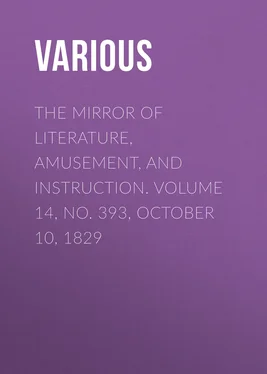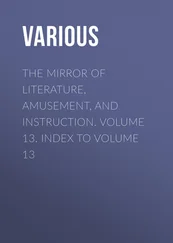Various - The Mirror of Literature, Amusement, and Instruction. Volume 14, No. 393, October 10, 1829
Здесь есть возможность читать онлайн «Various - The Mirror of Literature, Amusement, and Instruction. Volume 14, No. 393, October 10, 1829» — ознакомительный отрывок электронной книги совершенно бесплатно, а после прочтения отрывка купить полную версию. В некоторых случаях можно слушать аудио, скачать через торрент в формате fb2 и присутствует краткое содержание. Жанр: foreign_antique, periodic, Развлечения, foreign_edu, на английском языке. Описание произведения, (предисловие) а так же отзывы посетителей доступны на портале библиотеки ЛибКат.
- Название:The Mirror of Literature, Amusement, and Instruction. Volume 14, No. 393, October 10, 1829
- Автор:
- Жанр:
- Год:неизвестен
- ISBN:нет данных
- Рейтинг книги:3 / 5. Голосов: 1
-
Избранное:Добавить в избранное
- Отзывы:
-
Ваша оценка:
- 60
- 1
- 2
- 3
- 4
- 5
The Mirror of Literature, Amusement, and Instruction. Volume 14, No. 393, October 10, 1829: краткое содержание, описание и аннотация
Предлагаем к чтению аннотацию, описание, краткое содержание или предисловие (зависит от того, что написал сам автор книги «The Mirror of Literature, Amusement, and Instruction. Volume 14, No. 393, October 10, 1829»). Если вы не нашли необходимую информацию о книге — напишите в комментариях, мы постараемся отыскать её.
The Mirror of Literature, Amusement, and Instruction. Volume 14, No. 393, October 10, 1829 — читать онлайн ознакомительный отрывок
Ниже представлен текст книги, разбитый по страницам. Система сохранения места последней прочитанной страницы, позволяет с удобством читать онлайн бесплатно книгу «The Mirror of Literature, Amusement, and Instruction. Volume 14, No. 393, October 10, 1829», без необходимости каждый раз заново искать на чём Вы остановились. Поставьте закладку, и сможете в любой момент перейти на страницу, на которой закончили чтение.
Интервал:
Закладка:
Various
The Mirror of Literature, Amusement, and Instruction / Volume 14, No. 393, October 10, 1829
Glammis Castle
Here is a castellated palace, or princely castle, associated with many great and daring events in the roll of Scottish history. It stands in the valley of Strathmore, in a park of 160 acres, a little to the north of Glammis, a village of Angus, N.B. The original foundation is of high antiquity; for Malcolm II. was assassinated here in the year 1034, and the chamber in which he expired is still shown. Two obelisks, one near the Manse, and the other in a neighbouring field, denote the places where he was attacked. In this castle also, according to some historians, Macbeth murdered Duncan. We notice, however, that Sir Walter Scott, in his recently-published version of the story of Macbeth, states the murder to have been committed at "a great castle near Inverness," in which he is corroborated by Bæthius, who says, the castle stood upon an eminence south-east of Inverness. But Fordun says the murder was perpetrated near Elgin; and others say at Cawdor Castle.
The Castle originally consisted of two rectangular towers, longer than broad, with walls of fifteen feet in thickness; they were connected by a square projection, and together formed a figure somewhat like the letter Z, saving that in the castle all the angles were right ones; this form gave mutual defence to every part of the building. It contains a spiral staircase of 143 steps, reaching from the bottom to the top of the building.
Glammis Castle is still the seat of the Strathmore family. It was given by Robert I. of Scotland, in the year 1376, with his daughter, to John Lyon, Lord Glammis, chancellor of Scotland. Great alterations and additions were made to the building by Patrick, Earl of Strathmore, his lineal heir and successor: these improvements, according to the above cited plan, a date carved on a stone on the outside of the building, and other authorities, were made in the year 1606, and not in 1686, as is said in an old print engraved about that time, and from which our view is copied. The architect employed on this occasion, as tradition reports, was Inigo Jones; indeed, the work seems greatly to resemble Heriot's Hall at Edinburgh, and other buildings designed by him. The great hall was finished in the year 1621; it is a handsome room with a carved ceiling, adorned with heads and ornaments in stucco. Among the apartments shown to visitors, are a wardrobe containing a curious collection of old state dresses; the armoury, in which are preserved the sword and coat of mail of Macbeth, as well as some articles supposed to have been carried off by Malcolm's murderers, and found in the Loch of Forfar, during the last century; and the chapel built about 1500, the furniture of which remains in its original state. Here also are about one hundred portraits; among which is a large picture, in a carved frame, representing Earl Patrick and his three sons; in the background is a view of the castle, as it was in the year 1683. At that time there were three gates leading from the park. Some idea may be formed of the extent of this establishment from the circumstance of eighty beds being made up within the house, for the Pretender and his retinue, during their sojourn here, besides those for the inferior servants, in the offices out of doors. The forfeiture of the estate was prevented by the earl's brother being killed at the head of his regiment on Shiremore.
In the courtyard is shown a stone, on which is engraved a cross and divers figures, said to allude to the murder of Malcolm, and the death of the murderers, who attempting to cross the Lake of Forfar, then slightly frozen over, the ice broke, and they were drowned: this stone is described and engraved by Mr. Pennant, in his Tour through Scotland.
By way of enlivening these historical data, and as an epigrammatic conclusion to our description, we subjoin a pleasant little anecdote related by Sir Walter Scott, of a certain old Earl of Strathmore, who, in superintending some improvements of the castle, displayed an eccentric love of uniformity. "The earl and his gardener directed all in the garden and pleasure-grounds upon the ancient principle of exact correspondence between the different parts, so that each alley had its brother—a principle now renounced by gardeners. It chanced once upon a time that a fellow was caught committing some petty theft, and, being taken in the manner, was sentenced by the Bailie M'Wheeble of the jurisdiction to stand for a certain time in the baronial pillory, called the jougs , being a collar and chain attached to the uppermost portal of the great avenue which led to the castle. The thief was turned over accordingly to the gardener as the ground officer, to see the punishment duly inflicted. When the Thane of Glammis returned from his morning ride, he was surprised to find both sides of the gateway accommodated each with a prisoner. He asked the gardener, whom he found watching the place of punishment, as his duty required, whether another delinquent had been detected? 'No, my lord,' said the gardener, in the tone of a man excellently well satisfied with himself, 'but I thought the single fellow looked very awkward standing on one side of the gateway, so I gave half-a-crown to one of the labourers to stand on the other side for uniformity's sake .'"
ON LOCALITIES:
No intellectual enjoyment, in my opinion, can surpass the delight we experience when traversing those spots of the habitable earth where celebrated warriors fought, minstrels sang, philosophers pondered, or where philanthropists have immortalized their names by deeds of charity. To roam through the romantic vales of Italy—surrounded at all turns by the sad memorials of its former magnificence—the mighty ruins of its temples and palaces, and the mutilated remains of its statues and triumphal columns, conveying to the mind mournful images of the fallen fates of those who had for ages been its proud possessors; where the Mantuan bard first caught inspiration from the deathless muse; where Tully charmed the listening throng, whilst defending with mild persuasion the arts and the sciences he loved, and condemning in terrible denunciations the mad ambition that threatened the destruction of his country; to wander among its groves, and say, here Ovid, in lonely exile, soothed his sorrows with the melody of his heaven-inspired strain; here Petrarch wooed his much-loved Laura in sonnets soft as the affection that gave them birth; here Tasso made history and Jerusalem immortal by crowning them with the garlands of his Promethean genius; and here Ariosto, Dante, Metastasio, and a galaxy of poets and philosophers shed the splendour of their gifted imaginations on the expiring greatness of their country.
Where is the portion of the civilized globe that has not some delightful reminiscence connected with it? There is not a country in the world, even the most barbarous, where the inhabitants will not feel pride and pleasure in pointing out to your attention some sacred spot ever dear to their memories: some battle-field or scene of conquest; some warrior's grave; some monarch's sepulchre, or some chieftain or legislator's dwelling. And what shall we say of the classic soil of Greece? where the eye cannot turn, or the foot move to a place which is not eternalized by its associations: where the waters will not remind you of Castalian founts; the flowers of Parnassian wreaths; the eminences of the Phocian hills; and where the air of all breathes inspiration. To a mind prone to contemplation, a walk through Athens must awaken the most exquisite reveries. Although "fallen from its high estate," there is enough in the tottering ruins which yet remain to recall the history of its ancient grandeur: the shattered Acropolis and the Pyraeus tell the tale of other days, in language at once pathetic and intelligible—
Читать дальшеИнтервал:
Закладка:
Похожие книги на «The Mirror of Literature, Amusement, and Instruction. Volume 14, No. 393, October 10, 1829»
Представляем Вашему вниманию похожие книги на «The Mirror of Literature, Amusement, and Instruction. Volume 14, No. 393, October 10, 1829» списком для выбора. Мы отобрали схожую по названию и смыслу литературу в надежде предоставить читателям больше вариантов отыскать новые, интересные, ещё непрочитанные произведения.
Обсуждение, отзывы о книге «The Mirror of Literature, Amusement, and Instruction. Volume 14, No. 393, October 10, 1829» и просто собственные мнения читателей. Оставьте ваши комментарии, напишите, что Вы думаете о произведении, его смысле или главных героях. Укажите что конкретно понравилось, а что нет, и почему Вы так считаете.












